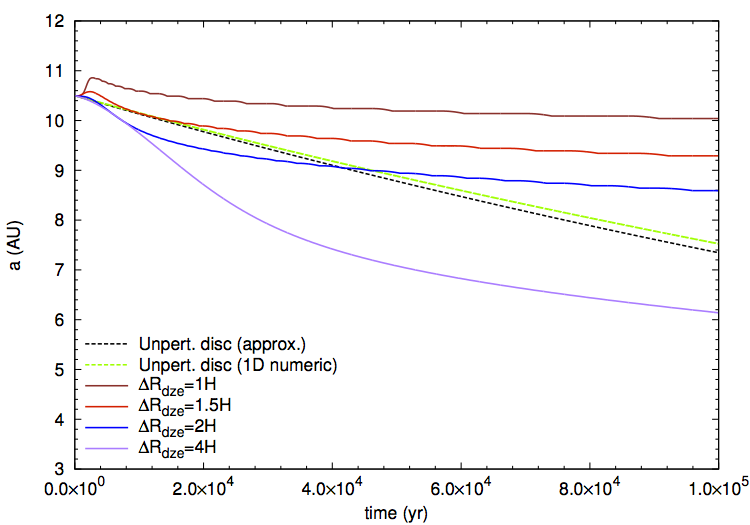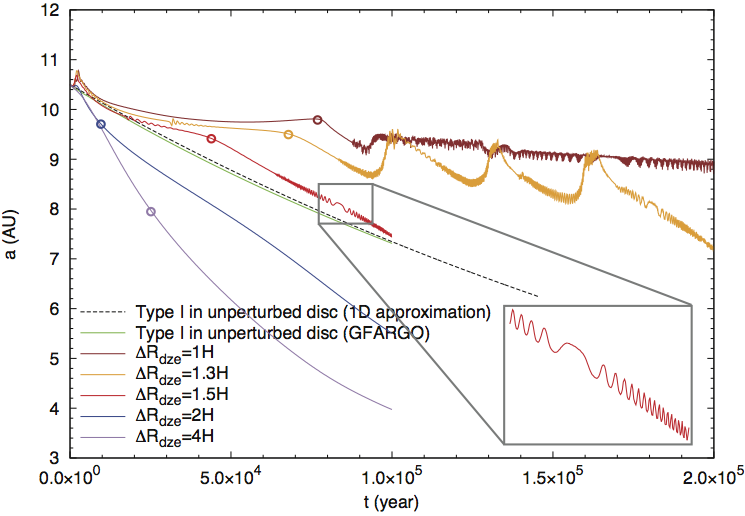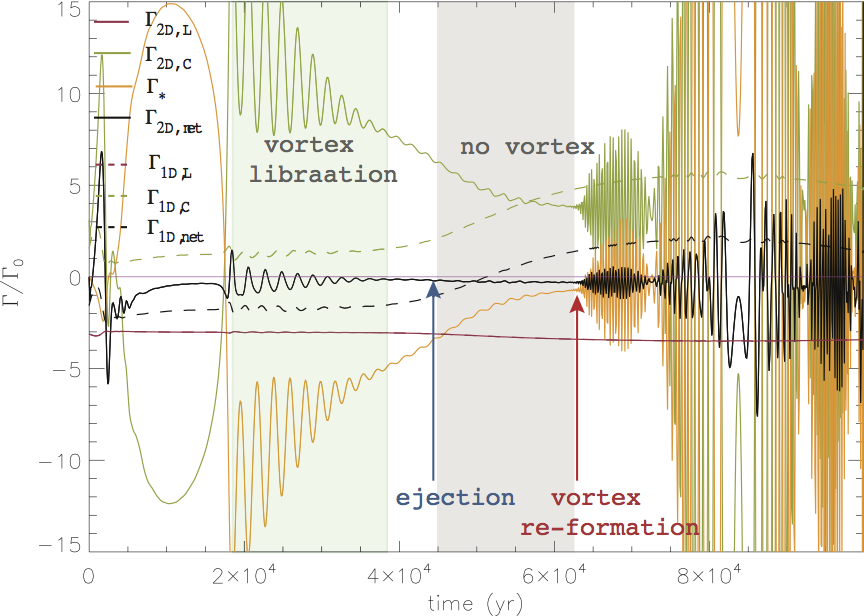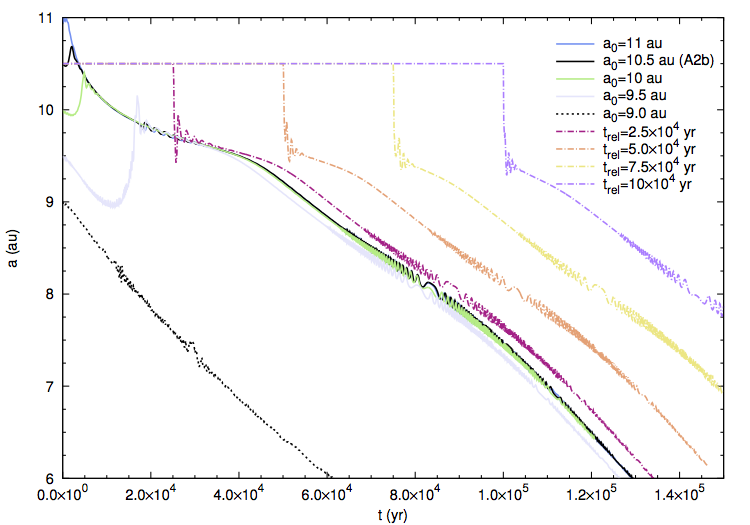In a series of papers we investigate how effective is the trapping of giant-planet cores by pressure bumps formed at dead zone edge of protoplanetary discs. First, we follow the orbital evolution of 10 Earth-mass planetary object in a locally isothermal global 2D disc model that has only outer dead zone edge. Incorporating in our model the viscous evolution of gas at the density maximum (formed near the dead zone edge), we show that a planetary core grown to the critical size of a 10 Earth-mass get trapped at the density maximum only in certain conditions, i.e. for which case large-scale vortex is developed (Regaly et al. 2013a). Secondly, we investigated how the above findings are a robust phenomena. To confirm this, we did an extended parameter study on the migration of a low-mass planet in which several physical parameters of the disc (mass, temperature, strength of the viscosity reduction in the dead zone, magnitude of global viscosity) and the planet mass are changed. This investigation involves about 100 simulations each lasts about 100-200⋅10^5 yr (Regaly et al. 2013b).
Trapping of giant-planet cores - I. Vortex aided trapping at the outer dead zone edge
|
The migration of a 10 Earth-mass planetary core is investigated at the outer boundary of the dead zone of a protoplanetary disc by means of 1D and 2D hydrodynamic simulations. In the dead zone, the effective viscosity is greatly reduced due to the disc self-shielding against stellar UV radiation, X-rays from the stellar magnetosphere and interstellar cosmic rays. As a consequence, mass accumulation occurs near the outer dead zone edge, which is assumed to trap planetary cores enhancing the efficiency of the core-accretion scenario to form giant planets. |
|
|
It is well known that the width of the region where viscosity reduction is taking place, i.e. the width of the dead zone edge determines whether the Rossby Wave Instability (RWI) is excited or not. For sharp dead zone edges, RWI is excited and large-scale vortex forms. However, if the viscosity reduction is taken place in a relatively wide region (twice wider than the local scaleheight of the disc), no RWI is excited, only ring-like density jump forms. According to the 1D approximation of the torque felt by a low-mass planet (for Type I migration, see eg. Paardekooper et al. 2010), a 10 Earth-mass planet is subject to trapping, independent of the width of the dead zone edge, which has been confirmed by our 1D simulations as well, see figure on the right. |
 1D trapping of a 10 Earth-mass planet 
1D trapping of a 10 Earth-mass planet |
|
Contrary to the perfect trapping of planetary cores in 1D models, our 2D numerical simulations done by the GPU version of FARGO code run on NVIDIA TESLA 2050 cards, show that the trapping effect is greatly dependent on the width of the dead zone edge. Planet trapping happens exclusively if the viscosity reduction is sharp enough to allow the development of large-scale vortices due to the RWI. The trapping is only temporarily, and its duration is inversely proportional to the width of the viscosity transition. However, if RWI is not excited, a ring-like axisymmetric density jump forms, which cannot trap the 10 Earth-mass planetary cores. |
 2D migration of a 10 Earth-mass planet 
2D migration of a 10 Earth-mass planet |
|
We revealed that the stellar torque exerted on the planet due to the shift of the barycentre, caused by the highly non-axisymmetric density distribution of the disc, plays a significant role in the planetary migration. The magnitude of the stellar torque exerted on the planet is significant in sharp dead zone edge models, and it is always opposite in sign compared to the corotation torque. |
|
|
For blunt viscosity transitions (dead zone edge width is larger than twice the local disc scale height), in which case RWI is not excited, no trapping of giant-planet core occurs. Interestingly, the migration rate of the 10 Earth-mass planet exceeds that in the conventional Type I regime. This can be explained by the attenuated corotation torque caused by the smaller vortensity-related horseshoe drag compared to the unperturbed disc models. |
|
|
Non-trapping of a 10 Earth-mass planet in model for which case the dead zone edge width is 2H. |
|
|
For sharp viscosity transitions (dead zone edge width is smaller than twice the local disc scale height), large-scale vortex forms due to RWI and the 10 Earth-mass giant-planet core is trapped. The torque exerted on the planet is highly oscillating. The trapping of the giant-planet core and the oscillating torque can be attributed to the interaction of high-magnitude oscillating corotation torque (caused by the vortex periodic perturbation on the horseshoe dynamics) and stellar torque (caused by the periodic shift of the barycentre of the system caused by the material accumulated inside the vortex). However, when the planet gets through the density maximum, the vortex disintegrates, resulting in declined average magnitude corotation and stellar torques. As a consequence, the giant-planet core feels larger negative disc torque on average and eventually ejected from the trap. |
|
|
Temporary trapping of a 10 Earth-mass planet in model for which case the dead zone edge width is 1.5H. |
|
|
After the ejection from the temporary trap, retrapping of giant-planet core occurs, if the width of the dead zone edge is sharp enough (dead zone edge with is 1.3 times the local disc scaleheight), due to the redevelopment of large-scale vortex. However, after a couple of retrapping, the planet finally leaves the trap and migrates towards the star with higher rate than that in the Type I regime. |
|
|
Retrapping of a 10 Earth-mass planet in model wheree the dead zone edge width is 1.3H. |
|
|
For even sharper dead zone edge models (dead zone edge width is equal to the local disc scale height), the giant-planet core is ejected but remained close to the density maximum up to 200⋅10^3 yr. This can be explained by the nearly vanishing average stellar torque and significant magnitude corotation torque. |
|
|
Long-lasting trapping of a 10 Earth-mass planet in model where the dead zone edge width is 1H. |
|
|
The discrepancy between the 1D and 2D simulations can be accounted for two assumptions made in the 1D simulations. On one hand, the 10 Earth-mass planet significantly perturbs the disc due to low viscosity (α=10^−4) in the dead zone. For these cases, even a 10 Earth-mass planet is able to open a partial gap in the disc as the viscous condition of gap opening is fulfilled. As a result, the horseshoe dynamics significantly changes compared to the unperturbed disc, which causes more negative total disc torque. On the other hand, the neglection of the azimuthal non-axisymmetry of the disc, especially in sharp viscosity transitions, results in the emergence of an additional stellar torque due to the shift of the barycentre. Since neither the partial gap opening, nor the barycentre shift are taken into account in 1D approximation, at least two-dimensional approach is required to model the migration of a 10 Earth-mass core of giant planet in a low-viscosity regime (α=10^−4) that develops in the dead zones. |
 Torques (co-rotation, differential Lindblad, and stellar torque) felt by the planet in 2D. 
Torques felt by the planet in 2D. |
|
Our final conclusion is that the outer dead zone edge might be highly effective in the temporary trapping of the giant-planet core and forming giant planet as the vortex acts as a gas reservoir. After the formation of giant planet, the migration in Type II regime is greatly reduced due to low viscosity in the dead zone. Note, however, that this scenario should be investigated in a more elaborated model, in which the viscous evolution of the density jump, the growth of planetary core and runaway gas accretion are modelled. |
|
Appeared in Regály, Zs.; Sándor, Zs.; Csomós, P.; Ataiee, S, 2013, MNRAS, Volume 433, Issue 3, p2626
ADS:2013MNRAS.433.2626;
arXiv:1305.5676
Trapping of giant-planet cores - II. Parameter study on the trapping at the outer dead zone edge
|
The ejection of a planetary core from the temporary trap is found to be triggered by the temporal disintegration of the large-scale vortex caused by the planet itself as it crosses the density maximum. The viscous evolution of the vortex and the planetary migration, therefore the life-time of the temporary trap too are expected to be dependent on the disc physical parameters such as the mass, magnitude of the global viscosity (α) and the reduced viscosity (δα) inside the dead zone, temperature (being equivalent to the disc thickness h), the steepness of the initial density profile (p), and the geometry being flat or flared (γ). In order to be convinced that the vortex aided trapping is a robust phenomenon, we investigated how the temporary trapping of a giant-planet core at the outer dead zone edge is affected by the change in the disc's physical parameters. Since the migration of a giant-planet core being not in Type II regime strongly depends on its mass, we investigated how the vortex aided trapping depends on the planetary mass too. |
|
|
The large-scale vortex (formed if the width of the outer dead zone edge is smaller than 1.8 au, in which case a large-scale vortex can be developed) provides a real trap for a giant-planet core in a sense that it pulls a giant-planet core into the trap either orbiting initially beyond or inside the radial distance of the trap (see Figure right), independent of the disc physical parameters being in the explored ranges. We found that a planet arrives to the trap from beyond the outer dead zone edge, never enters into the vortex eye, its azimuthal position with respect to the vortex centre is confined to the interval of -90°—90°. |
 Migration history with different initial orbital distance of the planet 
Migration history with different initial orbital distance of the planet. |
|
For very sharp outer dead zone edges (the width of the outer dead zone edge is smaller than 1.2 au, see movie below), the trapping of a planet with less than 10 Earth mass lasts longer than τ=2×10^5 yr independent of α, disc mass, p, γ, in the strong viscosity reduction (δα<0.01, i.e. the viscosity in the dead zone is low, α<10^-4) and hot disc (h>=0.05) regimes. |
|
|
Evolution of the azimuthal position of the trapped planet with respect to the centre of the large-scale vortex for very sharp (1.2 au) dead zone edge. |
|
|
For slightly wider outer dead zone edges (the width of the outer dead zone edge is smaller than 1.8 au, see movie below), the trapping is only temporary in a sense that the planet after ejected from the trap (even after several retrapping events) eventually migrates towards the star with larger migration rate than in the Type I regime. The characteristic trapping time is τ=4.7×10^4 yr, and increases with decreasing planetary mass, α, δα, h, p and increasing disc mass, γ. |
|
|
Evolution of the azimuthal position of the trapped planet with respect to the centre of the large-scale vortex for medium sharp (1.8 au) dead zone edge. |
|
|
For blunt outer dead zone edges (the width of the outer dead zone edge is larger than 2.4 au), no trapping of a 10 Earth mass planetary core occurs independent of the disc physical parameters being in the explored ranges. The overall migration rate is always exceeds that of in the conventional Type I regime. |
|
|
If the disc is flared (γ>2/3), the migration of a planetary-core is significantly slowed down, even in the absence of a disc dead zone. The migration is found to be in an intermediate regime between the conventional Type I and Type II due to partial gap opening. The non-vortex related planetary trap forms well inside the density maximum. |
|
|
For a very low-mass planetary core (the planetary mass is less than 2.5 Earth mass), the migration rate is significantly slowed down compared to the conventional Type I regime, even in blunt outer dead zone edge models. |
|
|
In some cases (α>0.02, the disc mass is less than 0.01 solar mass, and p<-1.0), the late-time evolution (t>1.5×10^5 yr) of the planetary semimajor axis become chaotic. Both the disc and planetary eccentricity are excited (with e=0.2 in average) due to a significant barycentre shift caused by a large amount of material accumulated inside the large-scale vortex. |
|
In preparation, Regály, Zs.; Sándor, Zs., 2013b, MNRAS
